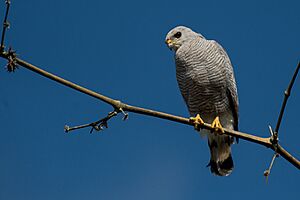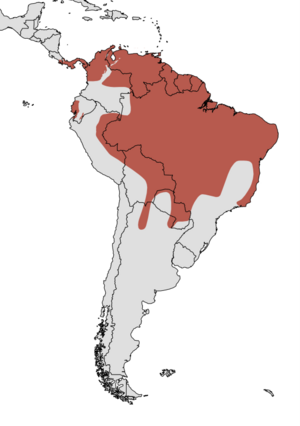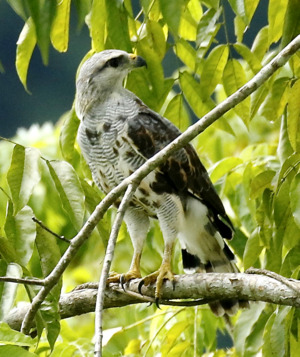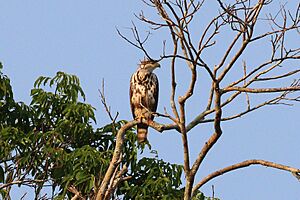Gray-lined hawk facts for kids
Quick facts for kids Gray-lined hawk |
|
|---|---|
 |
|
| Conservation status | |
| Scientific classification | |
| Genus: |
Buteo
|
| Species: |
nitidus
|
| Subspecies | |
|
|
 |
|
| Synonyms | |
|
Asturina nitida |
|
The gray-lined hawk (scientific name: Buteo nitidus) is a medium-sized bird of prey. You can find it in open areas and along the edges of forests. Sometimes, it's also called Asturina nitida. This hawk lives in many places, from El Salvador all the way down to Argentina. It also lives on the Caribbean island of Trinidad.
Contents
What Does the Gray-Lined Hawk Look Like?
The gray-lined hawk is about 46 to 61 centimeters (18 to 24 inches) long. It usually weighs around 475 grams (17 ounces).
Adult Hawks
Adult gray-lined hawks have a light gray body. Their tail is black with three white stripes. They have bright orange legs. Their upper feathers have thin white lines.
Young Hawks
Younger hawks look different. Their upper body is dark brown. Their tail is brown with light bands. Their belly is white with brown spots. Their head and neck are buff-colored with brown streaks. This hawk has fairly short wings. It can fly very fast and move quickly, especially for a Buteo hawk.
What Do Gray-Lined Hawks Eat?
Gray-lined hawks are skilled hunters. They mostly eat lizards and snakes. They also hunt insects like beetles and grasshoppers. Sometimes, they catch small mammals such as rabbits, squirrels, and mice. They will also eat other birds, frogs, toads, and even fish.
This hawk usually sits high up on a perch. From there, it watches for prey. Once it spots something, it swoops down to catch it. It can also hunt by flying low over the ground.
Reproduction and Life Cycle
Gray-lined hawks build their nests high up in trees. They make their nests out of sticks. A female hawk usually lays one to three eggs, but most often two. The eggs are white or light blue. The young hawks stay in the nest for about six weeks. After this time, they are ready to fly on their own.




